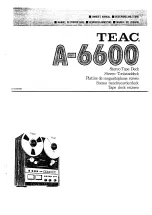
MEMORY MARKER
REPERE DE MEMOIRE
SPEICHERMARKIERUNGEN
Bei der Wiedergabe von Ton-Quellen,wie zum Beispiel
Musik, wo die Lautstärke plötzlich erheblich verstärkt oder
abgeschwächt werden kann, würde dies einen unnatürlichen
Effekt hervorrufen. Um solches zu vermeiden, wird die
Aufnahme-Technik EINBLENDUNG angewandt, bei
welcher die Aufnahme in geringer Lautstärke begonnen wird
und dann langsam ansteigt bis ein optimales Tonvolumen
erreicht wird, oder AUSBLENDUNG, wo der Ton gegen
Ende des Stücks langsam an Volumen abnimmt.
Um eine EINBLENDUNG zu ermöglichen, wird die
Aufnahme-Eingabe-Kontrolle langsam aufgedreht, bis die
Lautstärke für einen optimalen Aufnahme-Pegel erreicht
wird. Es ist jedoch notwendig, die Stellung des optimalen
Aufnahme-Pegels im voraus zu bestimmen.
Währenddessen wird im Falle einer AUSBLENDUNG die
Eingangs-Kontrolle vom optimalen Aufnahmepegel
herabgesetzt. Auch in diesem Falle ist es nötig, die
Stellung des optimalen Aufnahme-Pegels zu markieren. Da
die Speichermarkierung nicht gegen den Uhrzeigersinn mit
der Bewegung des Eingangs-Reglers verbunden ist,
vermag sie jederzeit die Stellung des optimalen Aufnahme-
Pegelsanzugeben. Vor allem für EINBLENDUNG, wo die
Eingangskontrolle von einer minimalen zu einer
maximalen Pegel-Stellung erhöht wird, ist es wichtig, daß
die optimale Stellung der Eingangskontrolle im voraus
angegeben wird.
Die Speichermarkierung bietet den Vorteil, daß sie auch
für EIN- und AUSBLENDUNGS-Operationen verwendet
werden kann, wenn sie auf eine optimale Lautstärke
eingestellt ist.
* Diese Speichermarkierung ist verzahnt, und obwohl sie in
der gewünschten Stellung stoppen wird, kann sie
falls erforderlich im Uhrzeigersinn gedreht wer-
den
Lorsqu'on enregistre de la musique, si 1'enregistrement
commence tout de suite ä fort volume ou si il s'arrete de
maniere abrupte 1'effet sera peu naturel. Pour palier ces
inconvenients an a recours ä la technique de "fondu",
technique qui permet de commencer un enregistrement ä
faible volume puis de 1'augmenter graduellement
jusqu'ä ce que le niveau optimum soit atteint, et
inversement en fin de bande, cette technique permet de
reduire progressivement le son.
Pour le fondu en debut de bande, il faut tourner
graduellement la commande d'entree d'enregistrement
jusqu'ä ce que le volume se trouve du niveau
optimum. Il est par consequent necessaire que la
position du niveau optimum soit reperee ä 1'avance.
En ce qui concerne le fondu en fin de bande, il faut
reduire graduellement le niveau d'entree ä partir de la
position de niveau optimum. 11 est egalement
necessaire dans ce cas d'avoir un repere de niveau
optimum d'enregistrement. Bien que le mouvement du
repere de memoire depende du mouvement de la
commande d'entree dans le sens des aiguilles d'une
montre, le repere peut ä tout moment indiquer le
niveau optimum d'enregistrement. II est
particulierement important que la position optimum de
commande d'entree soit indiquee ä 1'avance dans le
cas du fondu en debut de bande oü 1'on fait passer la
commande de bande du point de niveau minimum au
point optimum. La technique du fondu est ainsi
rendue plus facile gräce au repere de memoire.
* Le repere de memoire est asservi et bien qu'il puisse
rester Sur la position voulue an peut egalement le
tourner dans le sens des aiguilles d'une montre.
In the playback of sources such as music, if the
number is suddenly started in a large volume, or if it
suddenly ends in an abrupt manner, the effect would
be quite unnatural. To avoid such phenomena from
occurring, such recording techniques are employed as
those known as FADE-IN, which is the technique in
which recording is started in a small volume and then
is gradually raised until the optimum volume is
reached, or FADE-OUT, in which, the Sound at the
end of the number is gradually diminished from an
optimum volume.
To effect FADE-IN, the Recording Input Control is
gradually tuned up until the volume reaches an
optimum recording level. Thus, it is necessary to
have the position of the optimum recording level
marked in advance. Meanwhile, in the case of FADE-
OUT, the Input Control is gradually tuned down from
the position of the optimum recording level. In this
case too, it is necessary to have the position of the
optimum recording level marked. Since the Memory
Marker is not interlocked counterclockwise with the
movement of the Input Control, it is capable of
indicating the position of the optimum recording
level at all times. Notably for FADE-IN, in which the
Input Control is tuned from minimum up to the
optimum-level position, it is important that the
optimum position of the Input Control be indicated in
advance.
The Memory Marker, by being Set to the optimum
volume position, thus offers convenience in FADE-
IN and FADE-OUT operations.
* This Memory Marker is interlocked and although will
stop at the desired position it can be turned clockwise
if forced.






























